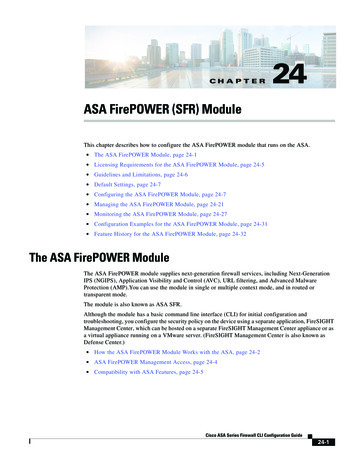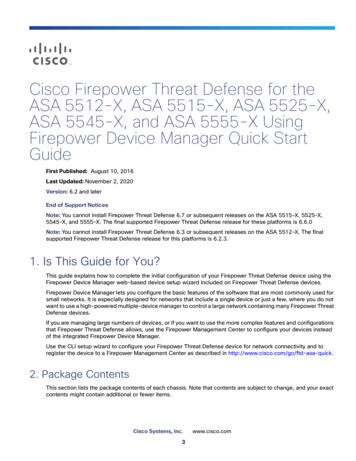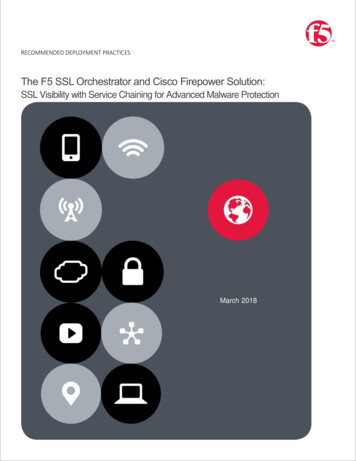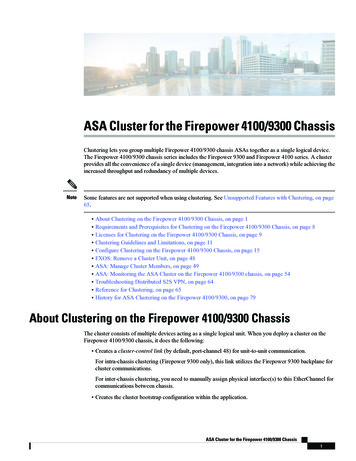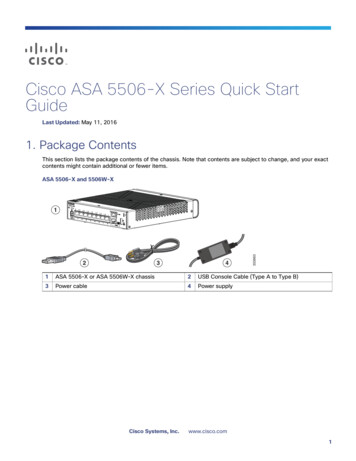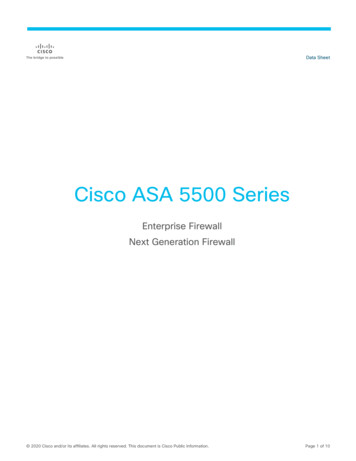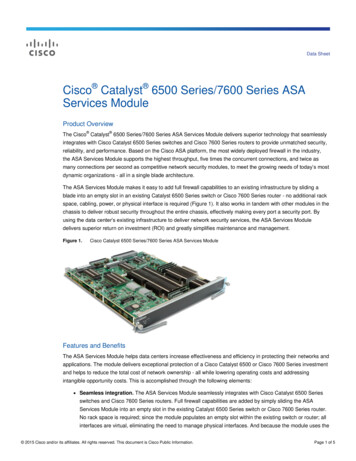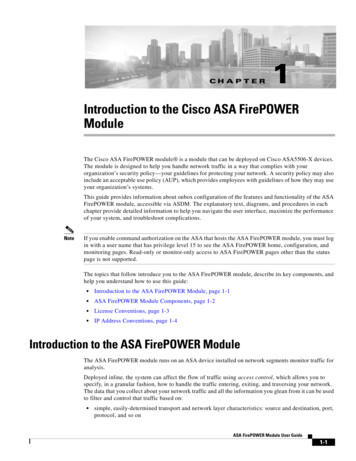
Transcription
CHAPTER45Licensing the ASA FirePOWER ModuleYou can license a variety of features to create an optimal ASA FirePOWER deployment for yourorganization.For more information, see: Understanding Licensing, page 45-1 Viewing Your Licenses, page 45-4 Adding a License to the ASA FirePOWER module, page 45-4 Deleting a License, page 45-5Understanding LicensingLicense: AnyYou can license a variety of features to create an optimal ASA FirePOWER deployment for yourorganization.Licenses allow your device to perform a variety of functions including: intrusion detection and prevention Security Intelligence filtering file control and advanced malware protection application, user, and URL controlThere are a few ways you may lose access to licensed features in the ASA FirePOWER module. You canremove licensed capabilities. Though there are some exceptions, you cannot use the features associatedwith an expired or deleted license.This section describes the types of licenses available in an ASA FirePOWER module deployment. Thelicenses you can enable on an appliance can depend the other licenses enabled.The following table summarizes ASA FirePOWER module licenses.Cisco ASA with FirePOWER Services Local Management Configuration Guide45-1
Chapter 45Licensing the ASA FirePOWER ModuleUnderstanding LicensingTable 45-1ASA FirePOWER Module LicensesLicenseGranted CapabilitiesRequiresProtectionintrusion detection and preventionnonefile controlSecurity Intelligence filteringControluser and application controlProtectionMalwareadvanced malware protection (network-basedmalware detection and blocking)ProtectionURL Filteringcategory and reputation-based URL filteringProtectionFor more information, see: Protection, page 45-2 Control, page 45-3 Malware, page 45-3 URL Filtering, page 45-3ProtectionLicense: ProtectionA Protection license allows you to perform intrusion detection and prevention, file control, and SecurityIntelligence filtering: Intrusion detection and prevention allows you to analyze network traffic for intrusions and exploitsand, optionally, drop offending packets. File control allows you to detect and, optionally, block users from uploading (sending) ordownloading (receiving) files of specific types over specific application protocols. With a Malwarelicense (see Malware, page 45-3), you can also inspect and block a restricted set of those file typesbased on their malware dispositions. Security Intelligence filtering allows you to blacklist—deny traffic to and from—specific IPaddresses, before the traffic is subjected to analysis by access control rules. Dynamic feeds allowyou to immediately blacklist connections based on the latest intelligence. Optionally, you can use a“monitor-only” setting for Security Intelligence filtering.Although you can configure an access control policy to perform Protection-related inspection without alicense, you cannot apply the policy until you first add a Protection license to the ASA FirePOWERmodule.If you delete your Protection license from the ASA FirePOWER module, the ASA FirePOWER modulestops detecting intrusion and file events. Additionally, the ASA FirePOWER module will not contact theinternet for either Cisco-provided or third-party Security Intelligence information. You cannot reapplyexisting policies until you re-enable Protection.Because a Protection license is required for URL Filtering, Malware, and Control licenses, deleting ordisabling a Protection license has the same effect as deleting or disabling your URL Filtering, Malware,or Control license.Cisco ASA with FirePOWER Services Local Management Configuration Guide45-2
Chapter 45Licensing the ASA FirePOWER ModuleUnderstanding LicensingControlLicense: ControlA Control license allows you to implement user and application control by adding user and applicationconditions to access control rules. To enable Control, you must also enable Protection.Although you can add user and application conditions to access control rules without a Control license,you cannot apply the policy until you first add a Control license to the ASA FirePOWER module.If you delete your Control license, you cannot reapply existing access control policies if they includerules with user or application conditions.URL FilteringLicense: URL FilteringURL filtering allows you to write access control rules that determine the traffic that can traverse yournetwork based on URLs requested by monitored hosts, correlated with information about those URLs,which is obtained from the Cisco cloud by the ASA FirePOWER module. To enable URL Filtering, youmust also enable a Protection license.TipWithout a URL Filtering license, you can specify individual URLs or groups of URLs to allow or block.This gives you granular, custom control over web traffic, but does not allow you to use URL categoryand reputation data to filter network traffic.URL filtering requires a subscription-based URL Filtering license. Although you can add category andreputation-based URL conditions to access control rules without a URL Filtering license, the ASAFirePOWER module will not contact the cloud for URL information. You cannot apply the accesscontrol policy until you first add a URL Filtering license to the ASA FirePOWER module.You may lose access to URL filtering if you delete the license from the ASA FirePOWER module. Also,URL Filtering licenses may expire. If your license expires or if you delete it, access control rules withURL conditions immediately stop filtering URLs, and your ASA FirePOWER module can no longercontact the cloud. You cannot reapply existing access control policies if they include rules with categoryand reputation-based URL conditions.MalwareLicense: MalwareA Malware license allows you to perform advanced malware protection, that is, use devices to detect andblock malware in files transmitted over your network. To enable Malware on a device, you must alsoenable Protection.You configure malware detection as part of a file policy, which you then associate with one or moreaccess control rules. File policies can detect your users uploading or downloading files of specific typesover specific application protocols. The Malware license allows you to inspect a restricted set of thosefile types for malware. The Malware license also allows you to add specific files to a file list and enablethe file list within a file policy, allowing those files to be automatically allowed or blocked on detection.Although you can add a malware-detecting file policy to an access control rule without a Malwarelicense, the file policy is marked with a warning icon ( ) in the access control rule editor. Within thefile policy, Malware Cloud Lookup rules are also marked with the warning icon. Before you can applyCisco ASA with FirePOWER Services Local Management Configuration Guide45-3
Chapter 45Licensing the ASA FirePOWER ModuleViewing Your Licensesan access control policy that includes a malware-detecting file policy, you must add a Malware license.If you later delete the license, you cannot reapply an existing access control policy to those devices if itincludes file policies that perform malware detection.If you delete your Malware license or it expires, the ASA FirePOWER module stops performingmalware cloud lookups, and also stops acknowledging retrospective events sent from the Cisco cloud.You cannot reapply existing access control policies if they include file policies that perform malwaredetection. Note that for a very brief time after a Malware license expires or is deleted, the system canuse cached dispositions for files detected by Malware Cloud Lookup file rules. After the time windowexpires, the system assigns a disposition of Unavailable to those files, rather than performing a lookup.Viewing Your LicensesLicense: AnyUse the Licenses page to view the licenses for an ASA FirePOWER module.Other than the Licenses page, there are a few other ways you can view licenses and license limits: The Product Licensing dashboard widget provides an at-a-glance overview of your licenses. The Device page (Configuration ASA FirePOWER Configuration Device Management Device) liststhe licenses.To view your licenses:Step 1Select Configuration ASA FirePOWER Configuration Licenses.The Licenses page appears.Adding a License to the ASA FirePOWER moduleLicense: AnyBefore you add a license to the ASA FirePOWER module, make sure you have the activation keyprovided by Cisco when you purchased the license. You must add licenses before you can use licensedfeatures.NoteIf you add licenses after a backup has completed, these licenses will not be removed or overwritten ifthis backup is restored. To prevent a conflict on restore, remove those licenses before restoring thebackup, noting where the licenses were used, and add and reconfigure them after restoring the backup.If a conflict occurs, contact Support.To add a license:Step 1Select Configuration ASA FirePOWER Configuration Licenses.The Licenses page appears.Step 2Click Add New License.Cisco ASA with FirePOWER Services Local Management Configuration Guide45-4
Chapter 45Licensing the ASA FirePOWER ModuleDeleting a LicenseThe Add License page appears.Step 3Did you receive an email with your license? If yes, copy the license from the email, paste it into the License field, and click Submit License.If the license is correct, the license is added. Skip the rest of the procedure. If no, click Get License.The Product License Registration portal appears. If you cannot access the Internet, switch to acomputer that can. Note the license key at the bottom of the page and browse tohttps://www.cisco.com/go/license.Step 4TipStep 5Follow the on-screen instructions to obtain your license, which will be sent to you in an email.You can also request a license on the Licenses tab after you log into the Support Site.Copy the license from the email, paste it into the License field in the ASA FirePOWER module’s webuser interface, and click Submit License.If the license is valid, it is added.Deleting a LicenseLicense: AnyUse the following procedure if you need to delete a license for any reason. Keep in mind that becauseCisco generates licenses based on each ASA FirePOWER module’s unique license key, you cannotdelete a license from one ASA FirePOWER module and then reuse it on a different ASA FirePOWERmodule.In most cases, deleting a license removes your ability to use features enabled by that license. For moreinformation, see Understanding Licensing, page 45-1.To delete a license:Step 1Select Configuration ASA FirePOWER Configuration Licenses.The Licenses page appears.Step 2Next to the license you want to delete, click the delete icon (Step 3Confirm that you want to delete the license.).The license is deleted.Cisco ASA with FirePOWER Services Local Management Configuration Guide45-5
Chapter 45Cisco ASA with FirePOWER Services Local Management Configuration Guide45-6Licensing the ASA FirePOWER Module
Cisco ASA with FirePOWER Services Local Management Configuration Guide 45 Licensing the ASA FirePOWER Module You can license a variety of features to create an optimal ASA FirePOWER deployment for your organization. For more information, see: Understanding Licensing, page 45-1 Viewing Your Licenses, page 45-4
